The Rood Loft and the Liturgical Gospel
Here is an article for all you liturgical minded
people out there, if you are not a medieval liturgical nerd like I am, read no further!
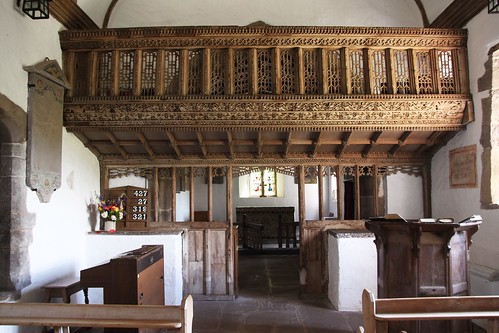 |
| The rood loft at Patrishow, Powys. |
There is a theory that in the late Middle Ages the
rood lofts of medieval parish churches in England and Wales, extending across
the chancel arch between chancel and nave, were the setting for the singing of
the liturgical Gospel during high mass.
Given that many medieval rood stairs giving access to lofts are narrow spiral
staircases (like those illustrated below) and are difficult to climb, even when not wearing vestments and
carrying a heavy book, I have never really quite believed this.
In any case there is visual and textual evidence, as I have discussed before on this blog that the liturgical Gospel was sung at the step of the high altar at a lectern facing north. Such a position is described in the Rites of Durham, that glorious record of the ceremonial and visual landscape of Durham Cathedral at the time of the Reformation and was clearly the use in Westminster Abbey too.
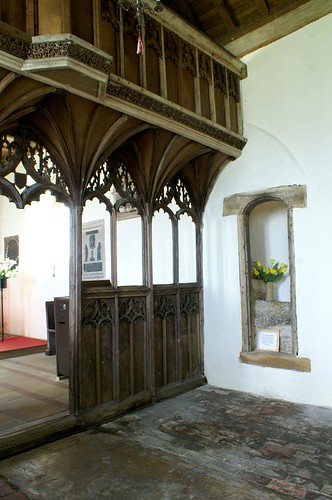 |
| The rood loft entry at Coates, by Stow, Lincolnshire. A narrow and uneven stair that is difficult to climb even without the sign and the flowers in the way! |
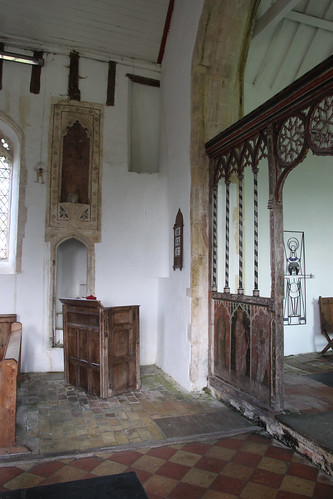 |
| The rood loft stair at Edingthorpe, Norfolk. Difficult access. |
In any case there is visual and textual evidence, as I have discussed before on this blog that the liturgical Gospel was sung at the step of the high altar at a lectern facing north. Such a position is described in the Rites of Durham, that glorious record of the ceremonial and visual landscape of Durham Cathedral at the time of the Reformation and was clearly the use in Westminster Abbey too.
‘At
the north end of the high altar, there was a goodly fine letteron [Lettern, H.
45] of brasse where they sunge the epistle and the gospell, with a gilt
pellican on the height of it finely gilded pullinge hir bloud out hir breast to
hir young ones, and winges spread abroade wheron did lye the book that they did
singe the epistle and the gosple’
J. T. Fowler, Rites of Durham Being a Description or Brief Declaration of All the Ancient Monuments, Rites & Customs Belonging or being Within the Monastical Church of Durham, Surtees Society 107 (1903), p. 13)
Such a position is also illustrated in a woodcut in Dat Boexken Vander Missen a block book
guide to the mass from the Low Countries, that was circulated and known in
England.
So on this basis I have shelved the rood loft/ambo
theory in the same compartment with as other wild (usually Victorian) theories as to
the purpose of various parts church building, such as the notion that
low-side windows in chancels were ‘leper windows’. Until recently, when I discovered some evidence that
has made me think again and return to the subject.
So what sources, textual and physical, are there to
indicate that the Gospel might have been sung/said high up in the air from the impractical and inaccessible rood loft? The first source we might
turn to is William Durandus Rationale Divinorum
Officiorum. Durandus was a French
bishop and this treatise, written
sometime in the third quarter of the thirteenth century, he describes the
ritual of the mass and the visual landscape of church buildings as he knew them
in France in his time. The treatise was
into English in 1843 by two Anglican ritualist clergy, John Mason Neale and
Benjamin Webb and the quote below comes from that translation.
‘When
Bishop or Priest celebrateth High Mass with the highest solemnity, then, in
some churches, as at Rome, the Deacon having kissed the right hand of the
Bishop taketh the Book of the Gospel from the Altar, and giveth it to the
Sub-Deacon to bear, and asketh and receiveth the Bishop's or Priest's blessing.
But in other churches, he first asketh for the blessing, before he taketh the
book. The Benediction having been bestowed, the Deacon proceedeth along the
South side of the Choir to the Rood Loft, and before him goeth the Sub Deacon
with the Volume of the Gospel, and before him the incense-bearer with incense;
and before him the torch bearer with lighted tapers, and before him in some
churches the Banner of the Cross: and thus they ascend the Rood Loft. And the
Deacon readeth the Gospel: the which being
finished, they return to the Priest or Bishop together’.
(J. M Neale and B. Webb, The Symbolism of Church and Church Ornaments: a Translation of the first book of the Rationale Divinorum Officiorum written by William Durandus (London, 1893), p. 218).
Ha, ha you say – here you go, here is the evidence that
we are looking for. However wait a
minute, the passage in Durandus raises more questions than it provides answers
to. Firstly Durandus is of course describing
the ceremonial that was common in France (and in Italy), in his time, not that
of England. Secondly what he describes
is the ceremonial of a French pontifical high mass, he is hardly describing the
ceremonial that accompanied the mass in an ordinary French parish church. Thirdly we are reading Durandus in
translation, we are relying on the interpretation here of the text by the translators. Neale and Webb in their translation have chosen
to translate the Latin word Analogium in
Durandus as ‘rood loft’. The word Analogium
is not synonymous with the term rood loft, it refers simply to a raised
platform – that could mean the loft above a rood screen, but it could mean anything
else from a single step above a floor, to a wineglass pulpit, or the raised Ambo
found in early medieval Italian churches.
In fact further along in the treatise Durandus refers to the deacon
ascending the ‘Ambo’ to read the Gospel (p.224).
So Durandus is a bit of a dead end. Setting him aside for a moment, what other textual
evidence is there that the rood loft in British churches may have been used for
the proclamation of the gospel? What about the rubrics of the missals? The
rubrics of the Sarum Missal, the most predominant of the uses of medieval
England, do speak of the place of the proclamation of the Gospel and give some
hints.
Et
sic procedat diaconus per medium Chori, ipsum Textum super sinistrum manum
solemniter gestando, ad Pulpitum accedat, thuribulario et ceroferiario
praecendentibus … et semper legatur Evangelium versus aquilonem, id est, boream
(pp. 12-14)
And
thus the deacon shall advance through the midst of the Quire, solemnly carrying
the Text itself in his left hand, with thurifer and taper-bearers preceding
him, to the Pulpit…. And the gospel shall always be read by a reader facing
north.
F. H. Dickinson, Missale Ad Usum Insignis et Praeclarae Ecclesiae Sarum, (Oxford, 1861-1883), pp. 12-14.
‘Through the midst of the choir’ suggests that the
deacon is heading to the west end of the quire and ‘to the pulpit’ suggests he
is perhaps heading to the solid stone screen called the ‘Pulpitum’ at the west
end of the choir, that once divided the chancel from the crossing of the cathedral
church. But the evidence is rather
ambiguous and in any case the ceremonial here described is the ceremonial of a well-resourced
Cathedral church, not that of a parish church.
With the textual evidence being rather ambiguous, what
then of the physical evidence. Is there
any evidence within surviving rood lofts, of their use for the proclamation of
the gospel? It has to be said that the physical evidence is
fairly scant and of limited scope, as few rood lofts actually remain after the
purge of the reigns of Edward VI and Elizabeth I and we don’t know how
representative the remaining examples are.
Howard and Crossley in their English
Church Woodwork, list five wooden lofts that incorporate projecting centre
bays that may have formed a Gospel Ambo.
Two of these at Coates-by-Stow and Sleaford in Lincolnshire have
projections facing west and Dunster, Montgomery and Newark, have projections facing
east. In none of these is there any
evidence of the remains of a ledge or lectern to support a book. Of course if these projections did
represent the place where the Gospel was read, the book may have been held by
the subdeacon or another minister as the deacon sung the Gospel.
Facing east or west, they hardly fulfil the requirement in the Missal rubrics that the Gospel be proclaimed facing north. At Tattershall in Lincolnshire, a collegiate church, there is a stone Pulpitum dating from 1528 that divides the collegiate quire from the parochial nave of this great church. On its eastern side is a projecting ‘tribune’ as Aymer Vallance terms it. He writes:
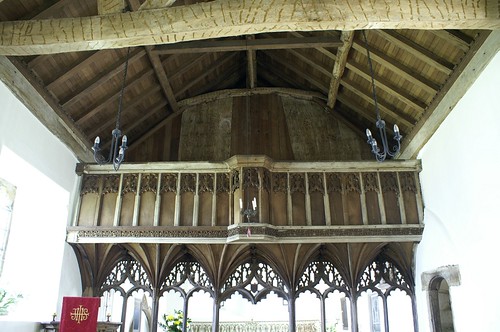 |
| The rood loft at Coates by Stow, Lincolnshire, with its projecting centre bay facing west. |
Facing east or west, they hardly fulfil the requirement in the Missal rubrics that the Gospel be proclaimed facing north. At Tattershall in Lincolnshire, a collegiate church, there is a stone Pulpitum dating from 1528 that divides the collegiate quire from the parochial nave of this great church. On its eastern side is a projecting ‘tribune’ as Aymer Vallance terms it. He writes:
‘A
notable feature of the parapet consists of two stone desks in the solid behind
the cresting. One of them … has a ledge
at the lower edge to hold a book from slipping.
The other desk facing north-east, just the place for the reader of the
Gospel, occupies the space behind the two outer Tudor flowers.’
(A. Vallance, Greater English Church Screens (London, 1947), p. 173)
This is the only physical evidence of a built in
screen lectern of any sort and as Vallance notes, the north-east facing stone
lectern would fulfil the Sarum rubric that the Gospel be sung facing north.
As with the Sarum rubrics, the evidence at Tattershall, a collegiate church, is hardly representative of the average parish church. So all told the physical evidence is rather ambiguous as well.
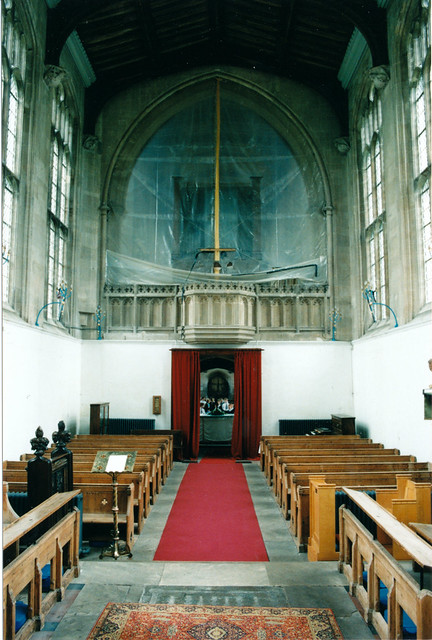 |
| The Tattershall Pulpitim showing the projecting 'Tribune' that incorporates stone built lecterns. |
As with the Sarum rubrics, the evidence at Tattershall, a collegiate church, is hardly representative of the average parish church. So all told the physical evidence is rather ambiguous as well.
Then this last week I had that Eureka moment. I am currently writing an article on the completion of majestic spire of the parish church of St James Louth in Lincolnshire as September is the 500th anniversary of its completion. As part of my research, I was reading the First Churchwardens Book of Louth as my bedtime reading. These are the accounts that cover the building of the spire, but also the general expenditure of the churchwardens between 1500 and 1524. By chance I came across the following items of expenditure within the accounts:
In 1517: ‘It. Paid Thomas Carfare 4 dais 2s. his
servand 4 dais 16d. making letrum in the rode loft and 1 paas (step) to stand
upon to rede gospels.’ p.187.
In 1522; ‘Thomas Carffare for making in rode lofte
to reede gospull upon 8d.’
(R. C. Dudding (ed.), The First Churchwardens' Book of Louth 1500-1524 (Oxford, 1941), p.214).
Thomas Carfarre is a joiner, who is paid for other
work including woodwork around the bells and also for ‘wainscot’, panelling in
the church. The accounts are clear, Carfarre is paid for making a lectern and a
step on which the deacon stands to read the Gospels. So at Louth in Lincolnshire at least, the
rood loft was indeed being used as a Gospel Ambo.
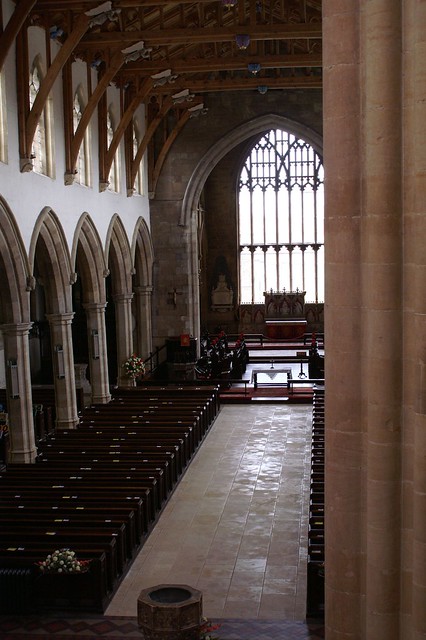 |
| The interior of St James Louth looking east towards the chancel arch and beyond to the high altar. The rood screen, long lost, was at the chancel arch. The loft was twenty foot above it. |
St James’s Louth is a grand building. It is built on the profits of trade, a
building that at the eve of the Reformation was richly furnished, was endowed
with multiple chapels, supported more than one choir who sang plainsong
accompanied by organs (also placed in the loft) and it supported a clerical
staff of some fifteen priests. In such
a visually rich and well-resourced context, clearly the proclamation of the
Gospel at high mass could be accompanied with rich a ceremonial that emulated
that of the greater cathedral churches.
The loft at Louth has gone, as has the screen, but the rood stair
remains. It is a narrow spiral staircase
built in the angle of the chancel arch and emerges some twenty foot from the
floor of the church. It would have been difficult to get up in vestments and
carrying a large book, but clearly here at Louth, that is precisely what they
did. It is tentative evidence I know, but
presumably other places did the same.
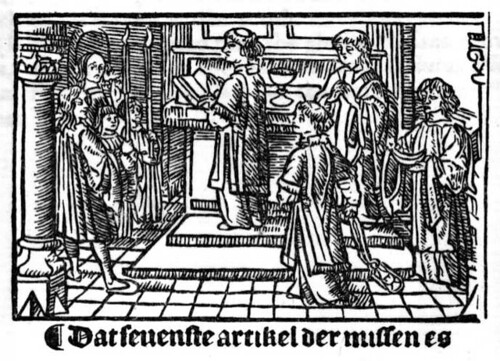

Comments
John the tradition of singing the Gospel facing north began in Rome in the sixth or seventh century, the Gospel was symbolically proclaimed towards the Northern Germanic pagan tribes.
One can watch as the Deacon, Sub-Deacon (who bears the Missal), Thurifer, two Acolytes and MC, process across The Sanctuary and take up positions which permit the Deacon to chant the Gospel (whilst facing Northwards).
Have a look on YouTube at the many High Mass Videos there. When the Gospel is chanted (by the Deacon), note the position of him. He is facing North.
in Domino
photo: http://www.davidcoupe.com/settle/eric_lucas/hubberholme%20church%20copy.jpg
It's good to see you posting again. I'm sure that you know of the account of Long Melford Church on the eve of the Reformation, written by Roger Martin around 1580 (most recently printed by David Dymond and Clive Paine in "Five Centuries of An English Parish Church"). In there he refers specifically to the Passion on Good Friday being sung from the roodloft, by a priest standing by the rood). But of course Long Melford was not an average parish church! One other point that others have made in the past is that if the roodloft had liturgical use you would expect them to be accessed from the chancel. As you say, they were often accessed (from the nave) by very narrow and steep, twisting stairs, with the foot of the stairs well above floor level, even now. One of the few lofts accessed from the chancel I can recall is at Villmaur-sur-Vanne, west of Troyes (pictures on Google).
Simon Cotton
There is a more recent translation of Durandus by Timothy M. Thibodeau:
The Rationale divinorum officiorum of William Durand of Mende: A New Translation of the Prologue and Book One, Columbia University Press, 2007.
He has also transpated at least one other book as well by the same press.
Gordon